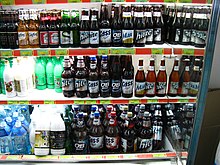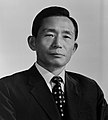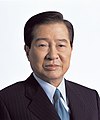Portal:South Korea
 |
환영합니다! / Welcome To The South Korea Portal!  South Korea, officially the Republic of Korea (ROK), is a country in East Asia. It constitutes the southern part of the Korean Peninsula and borders North Korea along the Korean Demilitarized Zone; though it also claims the land border with China and Russia. The country's western border is formed by the Yellow Sea, while its eastern border is defined by the Sea of Japan. South Korea claims to be the sole legitimate government of the entire peninsula and adjacent islands. It has a population of 51.96 million, of which roughly half live in the Seoul Capital Area, the ninth most populous metropolitan area in the world. Other major cities include Incheon, Busan, and Daegu. The Korean Peninsula was inhabited as early as the Lower Paleolithic period. Its first kingdom was noted in Chinese records in the early 7th century BCE. Following the unification of the Three Kingdoms of Korea into Silla and Balhae in the late 7th century, Korea was ruled by the Goryeo dynasty (918–1392) and the Joseon dynasty (1392–1897). The succeeding Korean Empire (1897–1910) was annexed in 1910 into the Empire of Japan. Japanese rule ended following Japan's surrender in World War II, after which Korea was divided into two zones: a northern zone occupied by the Soviet Union, and a southern zone occupied by the United States. After negotiations on reunification failed, the southern zone became the Republic of Korea in August 1948, while the northern zone became the communist Democratic People's Republic of Korea the following month. In 1950, a North Korean invasion began the Korean War, which ended in 1953 after extensive fighting involving the American-led United Nations Command and the People's Volunteer Army from China with Soviet assistance. The war left 3 million Koreans dead and the economy in ruins. The authoritarian First Republic of Korea led by Syngman Rhee was overthrown in the April Revolution of 1960. However, the Second Republic was incompetent as it could not control the revolutionary fervor. The May 16 coup of 1961 led by Park Chung Hee put an end to the Second Republic, signaling the start of the Third Republic in 1963. South Korea's devastated economy began to soar under Park's leadership, recording the one of fastest rises in average GDP per capita. Despite lacking natural resources, the nation rapidly developed to become one of the Four Asian Tigers based on international trade and economic globalization, integrating itself within the world economy with export-oriented industrialization. The Fourth Republic was established after the October Restoration of 1972, in which Park wielded absolute power. The Yushin Constitution declared that the president could suspend basic human rights and appoint a third of the parliament. Suppression of the opposition and human rights abuse by the government became more severe in this period. Even after Park's assassination in 1979, the authoritarian rule continued in the Fifth Republic led by Chun Doo-hwan, which violently seized power by two coups and brutally suppressing the Gwangju Uprising. The June Democratic Struggle of 1987 ended authoritarian rule, forming the current Sixth Republic. The country is now considered among the most advanced democracies in Continental and East Asia. (Full article...) Selected article -Beer, called maekju (Korean: 맥주; Hanja: 麥酒) in Korean, was first introduced to Korea in the early 20th century. Seoul's first brewery opened in 1908. Two current major breweries date back to the 1930s. The third brewery established in Korea, Jinro Coors Brewery, was founded in the 1990s. It was later acquired by Oriental Breweries (OB). Hite Breweries's former name was Chosun Breweries, which was established in 1933. The company changed its name to Hite Breweries in 1998. OB Breweries established as Showa Kirin Breweries in 1933. The company changed its name to OB Breweries in 1995. The South Korean beer market is currently dominated by two major manufacturers, Hite-Jinro and OB, with several brands being sold in the local market. Most restaurants and bars in Korea only have one of these beer brands on tap (Hite or OB's Cass), as they are largely regarded to be similar in taste and price (they are mostly brewed from rice). Imported beers are widely available in Korea, but are generally expensive - usually costing at least ₩8,000 and as much as ₩15,000 for a pint of Guinness in bars in downtown Seoul, versus approximately ₩3,000 for local brands. Recently, microbreweries have sprouted up throughout the country, showing increasing signs of sophistication. Out of South Korea's mass-produced beers, only two are brewed from 100% barley malt: Max (Hite) and OB Golden Lager. The lack of microbreweries in the South Korean market is attributed to onerous government regulations. This has constrained small-size brewers from supplying beer to locations under their ownership. These laws were eventually relaxed in June 2011, granting several small players a share in the local beer market. (Full article...)Selected image The Gold crown from Seobongchong Tumulus (Korean: 서봉총 금관; Hanja: 瑞鳳塚金冠; RR: Seobongchong geumgwan; MR: Sŏbongch'ong kŭmgwan), National Treasure of South Korea No. 339, is a gold crown of Silla origin that is now housed at the Gyeongju National Museum. More did you know -
In the news
This is a Good article, an article that meets a core set of high editorial standards.
 The heritage preservation system of South Korea is a multi-level program aiming to preserve and cultivate Korean cultural heritage. The program is administered by the Cultural Heritage Administration (CHA), and the legal framework is provided by the Cultural Heritage Protection Act of 1962, last updated in 2012. The program started in 1962 and has gradually been extended and upgraded since then. The CHA classifies cultural heritage into five major categories (state-designated heritage, city and province-designated heritage, cultural heritage material, registered cultural heritage, undesignated cultural heritage) and these are divided further into subcategories. Besides tangible cultural heritage, South Korea aims to preserve its intangible cultural heritage as well, including folk customs, music, dance and handicraft. The program also includes Living National Treasures, persons who possess the knowledge and skills important to pass down intangible cultural heritage to new generations. South Korea has founded several educational centers throughout the country and established a university, specifically dedicated to heritage preservation. Some of the heritage properties of South Korea has been inscribed into various UNESCO lists. As of 2014, the country has nine cultural and one natural World Heritage Sites, with 15 added to the provisional list; and there are 17 items registered as UNESCO intangible cultural heritage. (Full article...)General images -The following are images from various South Korea-related articles on Wikipedia.
Did you know (auto-generated)
WikiProjectsSee WikiProject Korea for collaborating on South Korea topics, and more broadly, on all things Korea-related. South Korea topics
CategoriesAdministrative divisions of South Korea
Related portalsEast Asia Associated WikimediaThe following Wikimedia Foundation sister projects provide more on this subject:
Web resources
SourcesDiscover Wikipedia using portals |
























































